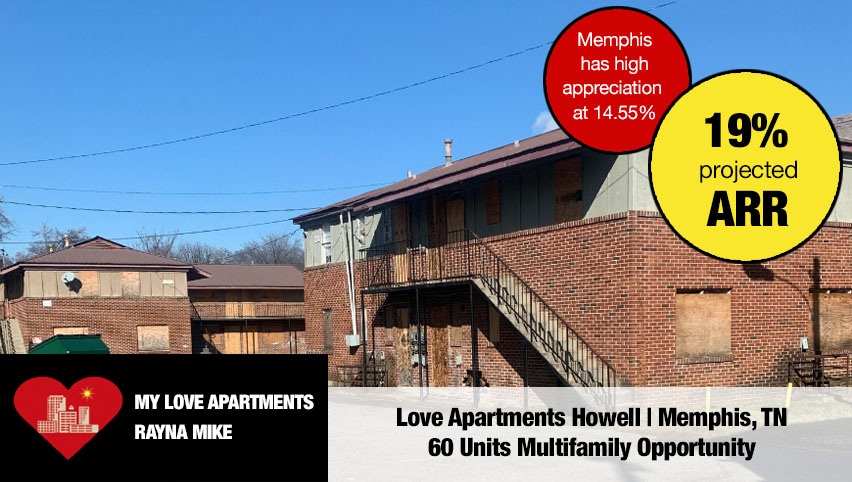1031 Exchange Highlights
1031 Exchanges, as defined under section 1031 of the IRS Code, is a strategy that allows you to defer paying capital gains taxes on an investment property. Using a 1031 Exchange, you pay no taxes on an investment property when it is sold as long as another “like-kind” property is purchased with the gains.
It is, when properly structured and administered, a very effective and powerful way for you to shift the focus of your investments while being able to legally defer tax payments.
MyLoveApartments offers investors two types of investments to exchange into when doing a 1031 Exchange:

MyLoveApartments apartment syndications
There is a common misconception that you can not do a 1031 exchange directly into a syndication. The good news is there are viable ways syndicators may facilitate a 1031 Exchange into their apartment syndications, but not all of them offer this capability. On select MyLoveApartments syndications we allow investors to exchange into the syndication.
To learn more, access our 1031 Exchange Into an Apartment Syndication FAQ

MyLoveApartments turnkey duplexes, triplexes, and fourplexes
For active investors that prefer 100% direct ownership, many of our MyLoveApartments turnkey rental property projects allow investors to use a 1031 Exchange to defer capital gains taxes when they buy in our of our build-to-rent multifamily communities consisting of fourplexes, triplexes, and/or duplexes.
Here are a few reasons you may want to consider replacing an existing rental property with another investment property:
If the current investment property is not performing well
To replace an aging property with a newer property
To own a property that requires less maintenance or has better property management
To scale a portfolio by freeing up cash to purchase a larger property
To transition from single-family to multifamily
To own a property in a better performing metro or neighborhood
But there are tax implications of selling your current investment property and then investing the proceeds in a new property. However, by utilizing a 1031 Exchange, you may be able to sell your current investment property and defer the capital gains by re-investing into another “like-kind” project.
What Our Investors Are Saying
⭐️⭐️⭐️⭐️⭐️
I was looking to invest in bigger projects. Rayna and her team helped me get started investing in commercial real estate and added more diversification to my portfolio. Love doing business with them!
– Phillip
⭐️⭐️⭐️⭐️⭐️
MyLoveApartments helped me increase my returns and helped me get my real estate business established – hands off! Now I sit back and watch the checks come in! I highly recommend MyLoveApartments to all investors.
– Donna
⭐️⭐️⭐️⭐️⭐️
When I was branching out into commercial real estate projects and apartment complexes, I knew I needed an expert. When I met Rayna, she showed me the possibilities and explained everything in a way that made sense. Since then we’ve more than doubled our revenue from their assistance and strategy.
– Randall
Frequently Asked Questions
What is a Tenants in Common (TIC) Structure?
In a Tenants in Common (TIC) structure, each of the co-owners gets an individual deed at the time of closing reflecting his or her undivided percentage interest in the entire property. TICs have been around for a while, and they have begun to gain more favor with those doing 1031 Exchanges. That’s because so many Exchangers have found it nearly impossible to locate replacement properties within the strict 45 days given by the IRS. The IRS seldom gives additional time to meet this requirement.
Using a TIC gives investors a lot more flexibility and diversification. Let’s say, for example, that you sell a small apartment building you’ve owned for 10 years and your equity is $300,000. Depending on any debt you still carry on the property, you could probably purchase a new investment of around one million dollars.
While that may seem like a lot of money to work, there is a chance that you still could not qualify to purchase an A- class property on your own. Investing that $300,000 in a TIC, though, could get you a million dollar interest in an institutional grade property.
Using a TIC you could become a passive investor in something like a luxury hotel or resort, office complex, apartment complex, or medical facility. This diversification could potentially assist you in reducing risk and increasing the value of your portfolio.
Additionally, it could also get you into a C or B class “heavy lift” value add project, without you having to do the heavy lifting. So you can realize the forced appreciation that these types of projects can offer without having to do the work. Instead, the full time professional asset management team is working to implement the business plan, while you enjoy the resulting increase in value of the asset.
What does the lifecycle of a 1031 Exchange project into a TIC look like?
Typically, 1031 investors may be more concerned about their tax savings than they are in investing in solid projects that have long-term earnings potential as well as tax benefits. Thankfully, we are able to provide a project that will not only meet the tax savings goals of investors but which also has tremendous upside potential.
We make easy for anyone wanting to use 1031 funds for the acquisition because we enter into a Co-Ownership Agreement with the 1031 person/entity that allows MyLoveApartments to manage that asset for them as if they were a passive investor. During the period of ownership, the 1031 person/entity will receive distributions according to the Co-Ownership Agreement.
Are there Additional Fees for 1031 Exchange participants?
While there are some additional fees for 1031 co-owners, they are reasonable.
Because participants in a 1031 Exchange are selling the relinquished property and buying a replacement property, they go through a standard closing for selling and buying real estate. This means that there are typically closing costs and a title policy. These costs are paid by the 1031 investor.
Anyone who uses 1031 funds in connection with an acquisition must be prepared to pay fees and costs associated with their participation. Those fees and costs will include ones charged by the 1031 Qualified Intermediary (QI) The QI is the company facilitating the exchange for the 1031 party). These fees and costs are typically under $1,000.
As a 1031 party you may also have your own legal fees and closing costs for the transaction. These costs can run several thousand dollars, but are based upon your own agreement with your lawyer or professionals on the transaction.
The asset manager (entity that manages the project) will also require that the 1031 pay their fair share of other fees and costs associated with managing the asset. Remember, as a 1031 party in this transaction, you are not managing the day to day operations. As such, the Manager will need to be paid. Typically, this is between 1-2% of the gross monthly revenue generated by the Property.
How do I fill out my 45 day paperwork to identify the project on my list?
The first step for anyone considering participating in a 1031 exchange is to locate and hire a Qualified Intermediary, which is an entity that specializes in assisting the TIC Owner in identifying propert(ies) that are compliant with the 1031 process.
How does the Debt Part work for 1031 investors that are bringing debt to the table?
If you have a 1031 property that you’re exchanging that includes both debt and cash, to qualify for the exchange, the debt must accompany the transaction. Here’s how a transaction would work if you’re exchanging a smaller 1031 property with cash and debt for an interest in a larger new development property. To meet the “like kind” exchange rules, the developer would sell you, using a purchase contract, an interest in the land for the cash you bring to the table and the lender would require you to guarantee a portion of the debt for the project to meet your 1031 requirement. Then, all the debt which incorporates your small loan would be serviced from the property’s revenue. There are some legal fees associated with these types of transactions, but the benefits are well worth it.
Remember – every 1031 party must use the funds realized from the sale of a property into the replacement property, otherwise a portion of the gain can be taxable. Let’s say you have a property you’re selling for $400,000; $250,000 of which is debt and the balance of $150,000 you’re getting in cash, you must find a property that can accept the cash and also provide enough debt to meet the qualifications of your 1031. Here’s how this type of transaction is handled on a larger property. If you want to use your 1031 exchange to invest in a $20 million apartment project, of which $2 million is the cost of the land. Using the $400,000 transaction example, you would enter into a purchase contract to buy $150,000 of the land. Then the sponsor would persuade the lender of the project to accept your $250,000 of debt as part of the overall loan. If the $20 million project had a $15 million loan, your $250,000 would be part of the $15 million in financing. Your portion of the debt would be the $250,000 you need to qualify, but the entire debt, including your $250,000 obligation would be serviced from the revenue from the project. Lenders are used to handling these types of transactions for developers.
What are lender requirements for a 1031 Exchange into a TIC?
If the 1031 investor is bringing debt to the transaction, they will be required to work with the lender’s legal counsel and maybe the syndicator’s legal counsel to ensure that the lender is comfortable bifurcating the loan for the benefit of the 1031 co-owner.
We try and make this as painless as possible by giving the Asset Manager a limited power of attorney to assist the 1031 party with executing documents required. It is important to note, however, that every 1031 party should be prepared to interact with the Asset Manager, the Borrower’s legal counsel, and the Lender’s underwriting team during the transaction, and to produce financials and personal information as requested.
How much of the equity needed can be brought into the project through 1031 Exchanges?
As a Tenants-in-Common (TIC) Owner, am I not an active investor?
The responsibilities for a TIC owner are set out in the Co-Ownership Agreement. MyLoveApartments endeavors to make it as stress-free and painless as possible for each TIC owner by requiring MyLoveApartments and not the TIC owner to be the day-to-day asset manager of the property.
This allows a TIC owner to have greater peace of mind knowing that another Co-Owner is tending to the day-to-day business of the property.
How is the Percentage of the Co-Ownership Calculated?
First, the percentage ownership in the land and/or improvements relates to the assets being acquired not to the relationship between the 1031 co-owners in the TIC and the other investors in the LLC portion of the structure.
Also, understand that we base everything on contributed capital (the equity you are bringing in) to determine your ownership. We give no value for debt that a TIC owner had to include to meet their 1031 exchange obligations. Furthermore, a 1031 investor can have one percentage ownership in the land and/or assets acquired and a different percentage when it comes to ownership in the project.
For example, if the land is worth $1,400,000 and a 1031 investor contributes $140,000, they would own 10% of the land, however, if the total capital raise is $5,900,000, which represents 80% ownership in the project, the 1031 investor would own 1.9% of the project ($140,000 / $7,375,000 = .019 or 1.9%). To get the denominator in the equation, divide $5,900,000 by 0.80. ($5,900,000 / .8 = $7,375,000).


